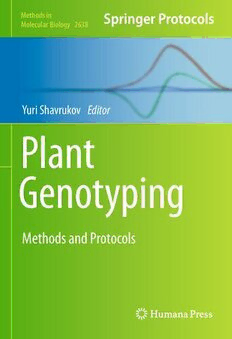
Plant Genotyping: Methods and Protocols PDF
Preview Plant Genotyping: Methods and Protocols
Methods in Molecular Biology 2638 Yuri Shavrukov Editor Plant Genotyping Methods and Protocols M M B ETHODS IN OLECULAR IO LO GY SeriesEditor JohnM.Walker School of Lifeand MedicalSciences University ofHertfordshire Hatfield, Hertfordshire, UK Forfurther volumes: http://www.springer.com/series/7651 For over 35 years, biological scientists have come to rely on the research protocols and methodologiesinthecriticallyacclaimedMethodsinMolecularBiologyseries.Theserieswas thefirsttointroducethestep-by-stepprotocolsapproachthathasbecomethestandardinall biomedical protocol publishing. Each protocol is provided in readily-reproducible step-by step fashion, opening with an introductory overview, a list of the materials and reagents neededtocompletetheexperiment,andfollowedbyadetailedprocedurethatissupported with a helpful notes section offering tips and tricks of the trade as well as troubleshooting advice. These hallmark features were introduced by series editor Dr. John Walker and constitutethekeyingredientineachandeveryvolumeoftheMethodsinMolecularBiology series. Tested and trusted, comprehensive and reliable, all protocols from the series are indexedinPubMed. Plant Genotyping Methods and Protocols Edited by Yuri Shavrukov College of Science and Engineering, Biological Sciences, Flinders University, Adelaide, SA, Australia Editor YuriShavrukov CollegeofScienceandEngineering BiologicalSciences FlindersUniversity Adelaide,SA,Australia ISSN1064-3745 ISSN1940-6029 (electronic) MethodsinMolecularBiology ISBN978-1-0716-3023-5 ISBN978-1-0716-3024-2 (eBook) https://doi.org/10.1007/978-1-0716-3024-2 ©TheEditor(s)(ifapplicable)andTheAuthor(s),underexclusivelicensetoSpringerScience+BusinessMedia,LLC,part ofSpringerNature2023 Thisworkissubjecttocopyright.AllrightsaresolelyandexclusivelylicensedbythePublisher,whetherthewholeorpart of the material is concerned, specifically the rights of translation, reprinting, reuse of illustrations, recitation, broadcasting,reproductionon microfilmsorinanyotherphysicalway,andtransmissionorinformation storageand retrieval,electronicadaptation, computersoftware,orbysimilar ordissimilar methodologynow knownorhereafter developed. Theuseofgeneraldescriptivenames,registerednames,trademarks,servicemarks,etc.inthispublicationdoesnotimply, evenintheabsenceofaspecificstatement,thatsuchnamesareexemptfromtherelevantprotectivelawsandregulations andthereforefreeforgeneraluse. Thepublisher,theauthors,andtheeditorsaresafetoassumethattheadviceandinformationinthisbookarebelievedto betrueandaccurateatthedateofpublication.Neitherthepublishernortheauthorsortheeditorsgiveawarranty, expressedorimplied,withrespecttothematerialcontainedhereinorforanyerrorsoromissionsthatmayhavebeen made.Thepublisherremainsneutralwithregardtojurisdictionalclaimsinpublishedmapsandinstitutionalaffiliations. ThisHumanaimprintispublishedbytheregisteredcompanySpringerScience+BusinessMedia,LLC,partofSpringer Nature. Theregisteredcompanyaddressis:1NewYorkPlaza,NewYork,NY10004,U.S.A. Preface “Thedearoldmagnolias!”saystheyoungman,pinchingoneofmyleaves. “I love them all”. – Magnolia! Well, wouldn’t that--say! Those innocents thoughtIwasamagnolia!Whatthe--well,wasn’tthattoughonagenuine littleoldNewYorkrubberplant?”... This “sentimental dialog” from The Rubber Plant’s Story (1917) by the renowned American short story writer O’Henry reflects how commonly humans are confused by plantidentification. Our life is always surrounded by plants, and we observe their external traits as plant phenotypes.Incontrast,wecannotdirectlyseeplantgenotypes,thesetofgeneticmaterial thatencodesthesephenotypictraits.Tomakegenotypesaccessibleforresearchandunder- standing,variousgenotypingmethodsareused.Genotypingcanbeemployedtostudythe origin of plant characteristics and traits, where each plant has a unique genotype. Many methodsofplantgenotypingwereinitiallydevelopedformedicalresearch,butallgenotyp- ing methods, if they are to be successful, should be suitable for application across the full rangeofstudieswithinplantbiology.Thisrelatesparticularlytothehundredsofthousands of offspring generated in plant progenies through diverse types of plant propagation (i.e., sexual and clonal, self- and cross-pollination) and across the relatively short life cycles of annualplantspecieswhichofcourseincludethemajorityofcropspecies.Plantgenotyping methods may be based on a variety of assessments, including DNA microarray, with its hundreds of thousands of simultaneous reactions, or separate individual studies of DNA sequencing and fragment analysis, PCR and qPCR, allele-specific molecular probes and primers,digestion withrestrictionendonucleases,microscopy,and manyothers.Resultsof plant genotyping can be easily converted into molecular markers, which can then be used notonlyforacademicstudybutmoreimportantlyforpracticalapplicationincropbreeding, biodiversityandbiosecurity,andanalysisof foodproductsfromplants.Therefore,methods ofplantgenotypingandtheirresultsareveryimportantforourfutureandthefutureofour globalbiosphere. Thecurrentbookrepresentsthewiderangeofexistingmethods,fromtheverypopular tothemoreexoticandrarelyused.Eachresearcheristhereforeawardedtheopportunityto updatetheirknowledgeandchoosethemostsuitablemethodofplantgenotypingfortheir chosenapplication. Adelaide,Australia YuriShavrukov v Contents Preface ..................................................................... v Contributors................................................................. xi 1 GenotypingbySequencing(GBS)forGenome-WideSNP IdentificationinPlants...... ........ ....... ....... ........ ....... ........ 1 WiruldaPootakham 2 GenotypingbyMultiplexedSequencing(GMS)UsingSNPMarkers.......... 9 TravisM.Ruff,KarolMarlowe,MarcusA.Hooker, YanLiu,andDevenR.See 3 ComputationalProtocolforDNAMethylationProfilinginPlants UsingRestrictionEnzyme-BasedGenomeReduction ........ ....... ........ 23 WendellJacintoPereira,Marı´liadeCastroRodriguesPappas, andGeorgiosJoannisPappasJr. 4 DoubleDigestRestriction-SiteAssociatedDNASequencing (ddRADseq)Technology ........... ....... ....... .... .... ...... ....... .. 37 NataliaCristinaAguirre,CarlaValeriaFilippi,PabloAlfredoVera, AndreaFabianaPuebla,GiusiZaina,Ver(cid:2)onicaVivianaLia, SusanaNoemı´ MarcucciPoltri,andNormaBeatrizPaniego 5 WholeGenomeWideSSRMarkersIdentificationBased onddRADseqData ........ ........ ....... ....... ........ ....... ........ 59 GitanjaliTandon,SarikaJaiswal,MirAsifIquebal, AnilRai,andDineshKumar 6 High-ThroughputAssociationMappinginBrassicanapusL.: MethodsandApplications .......... ....... ....... ........ ....... ........ 67 RafaqatAliGill,MdMostofaUddinHelal, MinqiangTang,MingHu,ChaoboTong,andShengyiLiu 7 PolyploidSNPGenotypingUsingtheMassARRAYSystem ...... .... ........ 93 AlinedaCostaLimaMoraes,DaniloAugustoSforc¸a, MelinaCristinaMancini,BiancaBacciliZanottoVigna, andAnetePereiradeSouza 8 qPCRGenotypingofPolyploidSpecies...... ....... ........ ....... ........ 115 HaiyanWang,JiangboDang,QigaoGuo,andGuoluLiang 9 Genome-WideAssociationStudies(GWAS)......... ........ ....... ........ 123 JianboHeandJunyiGai 10 TranscriptomicApproachforGlobalDistributionofSNP/Indel andPlantGenotyping...... ........ ....... ....... .. ... ... ....... ........ 147 ClaudiaMun˜oz-Espinoza,MarcoMeneses,andPatricioHinrichsen 11 Specific-LocusAmplifiedFragmentSequencing(SLAF-Seq) ......... ........ 165 YangZhouandHuitangPan vii viii Contents 12 ModificationsofKompetitiveAllele-SpecificPCR(KASP)Genotyping forDetectionofRareAlleles ........ ....... ....... ........ ....... ........ 173 AnthonyBrusa,EricPatterson,andMargaretFleming 13 Amplifluor-BasedSNPGenotyping ......... ....... ........ ....... ........ 191 ManmodeDarpanMohanrao,SenapathySenthilvel, YarabapaniRushwanthReddy,ChippaAnilKumar, andPalchamyKadirvel 14 SNPGenotypingwithAmplifluor-LikeMethod ..... ........ ....... ........ 201 GulmiraKhassanova,SholpanKhalbayeva,DaurenSerikbay, ShynarMazkirat,KulpashBulatova,MaralUtebayev, andYuriShavrukov 15 Semi-Thermal AsymmetricReversePCR(STARP)Genotyping... .... ...... .. 221 AwaisRasheed 16 ModifiedAllele-SpecificqPCR(ASQ)Genotyping........ ... ....... ........ 231 AigulAmangeldiyeva,AkmaralBaidyussen,MarzhanKuzbakova, RaushanYerzhebayeva,SatyvaldyJatayev,andYuriShavrukov 17 Allele-SpecificMutationGenotypingwithMismatches inPrimerDesign.... ....... ........ ....... ....... ........ ....... ........ 249 YutaroSaito,FumitoTada,TadashiTakashina, andHidetoshiIkegami 18 PCRAlleleCompetitiveExtension(PACE) ......... ........ ....... ...... .. 263 DanielvonMaydell 19 MolecularBeaconProbe(MBP)-BasedReal-TimePCR .. .... ....... ........ 273 GopalKumarPrajapati,AshutoshKumar, AakankshaWany,andDevManiPandey 20 MolecularBeacons–Loop-MediatedAmplification(MB-LAMP)..... ........ 289 PatrickHardinge 21 TaqManProbesforPlantSpeciesIdentificationandQuantification inFoodandFeedTraceability....... ....... ....... ........ ....... ........ 301 MariaDoroteiaCampos,CatarinaCampos,andHe´liaCardoso 22 Tetra-PrimerAmplificationRefractoryMutationSystem(T-ARMS)........... 315 ArnabMukherjeeandTirtharthaChattopadhyay 23 Penta-PrimerAmplificationRefractoryMutationSystem(PARMS) withDirectPCR-BasedSNPMarker-AssistedSelection(D-MAS) .... ...... .. 327 ChaoTanandYanyuYang 24 High-ResolutionMelting(HRM)Genotyping ...... ........ ....... ........ 337 NayoungKim,Ji-SuKwon,Won-HeeKang,andSeon-InYeom 25 ModifiedHigh-ResolutionMelting(HRM)MarkerSystems IncreasingDiscriminabilityBetweenHomozygousAlleles .... ....... ........ 351 SatoshiWatanabe,YoshiyukiYamagata,andNobuhiroKotoda 26 ANewSNPGenotypingTechnologybyTargetSNP-Seq..... ....... ........ 365 JianZhang,JingjingYang,andChanglongWen Contents ix 27 DerivedPolymorphicAmplifiedCleavedSequence(dPACS)Assay.... ........ 373 ShivShankharKaundun,Sarah-JaneHutchings, JoeDownes,andKenBaker 28 Tubulin-BasedPolymorphism(TBP)inPlantGenotyping.... ....... ........ 387 LucaBraglia,FlorianaGavazzi,SilviaGianı`, LauraMorello,andDiegoBreviario 29 MultiplexedISSRGenotypingbySequencing(MIG-Seq) .... ....... ........ 403 SatoshiNanami 30 ApplicationofSolCAPGenotypinginPotato(SolanumtuberosumL.) AssociationMapping....... ........ ....... ....... ........ ....... ........ 415 MuhammadFarhanYousaf,MuhammadAbuBakarZia, andMuhammadNaeem 31 FluorescenceInSituHybridization(FISH)for theGenotyping ofTriticeaeTribeSpeciesandHybrids....... .... ... ........ ....... ........ 437 IrinaAdonina 32 InnovativeAdvancesinPlantGenotyping.... ....... ........ ....... ........ 451 WilliamJ.W.Thomas,YueqiZhang,JunreyC.Amas,AldrinY.Cantila, JacoD.Zandberg,SamanthaL.Harvie,andJacquelineBatley Index .......... ........ ....... ........ ....... ....... ........ ....... ........ 467 Contributors IRINA ADONINA • InstituteofCytologyandGenetics,RussianAcademyofSciences,Siberian Branch,Novosibirsk,Russia NATALIACRISTINAAGUIRRE • InstitutodeAgrobiotecnologı´ayBiologı´aMolecular(IABiMo), UnidadEjecutoradeDobleDependenciaInstitutoNacionaldeTecnologı´aAgropecuaria (INTA)–ConsejoNacionaldeCienciayTe´cnica(CONICET),Hurlingham,Argentina AIGULAMANGELDIYEVA • KazakhResearchInstituteofAgricultureandPlantGrowing, Almalybak,Almaty,Kazakhstan JUNREY C.AMAS • SchoolofBiologicalSciences,UniversityofWesternAustralia,Perth,WA, Australia AKMARALBAIDYUSSEN • S.SeifullinKazakhAgroTechnicalUniversity,Astana,Kazakhstan KENBAKER • GeneralBioinformatics,Jealott’sHillInternationalResearchCentre, Berkshire,UK JACQUELINEBATLEY • SchoolofBiologicalSciences,UniversityofWesternAustralia,Perth, WA,Australia LUCA BRAGLIA • InstituteofAgriculturalBiologyandBiotechnology(IBBA),Milan,Italy DIEGOBREVIARIO • InstituteofAgriculturalBiologyandBiotechnology(IBBA),Milan,Italy ANTHONYBRUSA • DepartmentofAgronomyandPlantGenetics,UniversityofMinnesota, Minneapolis,MN,USA KULPASHBULATOVA • KazakhResearchInstituteofAgricultureandPlantProduction, Almalybak,Almaty,Kazakhstan CATARINACAMPOS • MED-MediterraneanInstituteforAgriculture,Environmentand Development&CHANGE-GlobalChangeandSustainabilityInstitute,Institutefor AdvancedStudiesandResearch,UniversidadedeE´vora,Evora,Portugal MARIADOROTEIACAMPOS • MED-MediterraneanInstituteforAgriculture,Environment andDevelopment&CHANGE-GlobalChangeandSustainabilityInstitute,Institutefor AdvancedStudiesandResearch,UniversidadedeE´vora,Evora,Portugal ALDRIN Y.CANTILA • SchoolofBiologicalSciences,UniversityofWesternAustralia,Perth, WA,Australia HE´LIACARDOSO • MED-MediterraneanInstituteforAgriculture,Environmentand Development&CHANGE-GlobalChangeandSustainabilityInstitute,Institutefor AdvancedStudiesandResearch,UniversidadedeE´vora,Evora,Portugal TIRTHARTHACHATTOPADHYAY • DepartmentofPlantBreedingandGenetics,Bihar AgriculturalCollege,BiharAgriculturalUniversity,Sabour,Bhagalpur,Bihar,India ALINEDACOSTALIMAMORAES • DepartmentofPlantBiology,BiologyInstitute,Universityof Campinas(UNICAMP),Campinas,Brazil JIANGBODANG • KeyLaboratoryofHorticultureScienceforSouthernMountainsRegionsof MinistryofEducation,CollegeofHorticultureandLandscapeArchitecture,Southwest University,Beibei,Chongqing,China MARI´LIADECASTRORODRIGUESPAPPAS • EmbrapaGeneticResourcesandBiotechnology, Brasilia,DistritoFederal,Brazil xi
